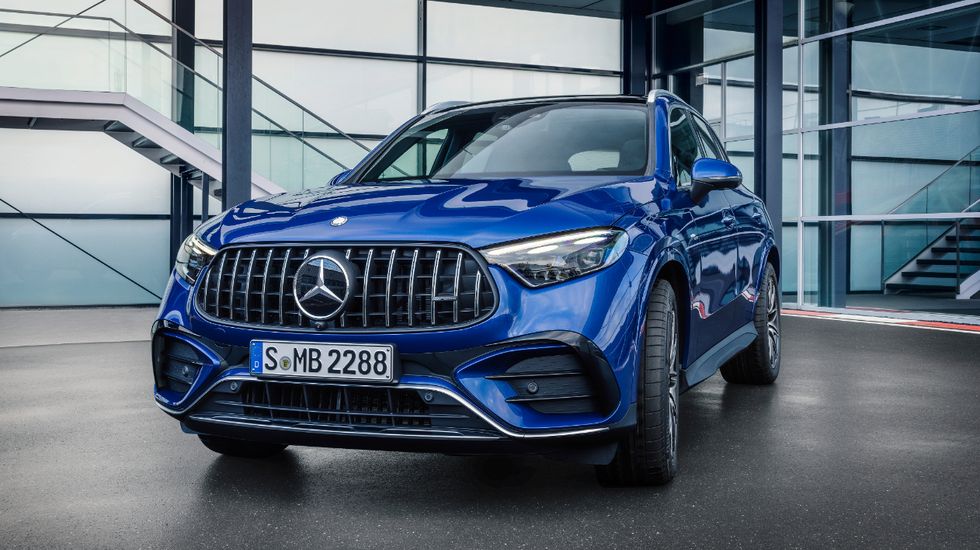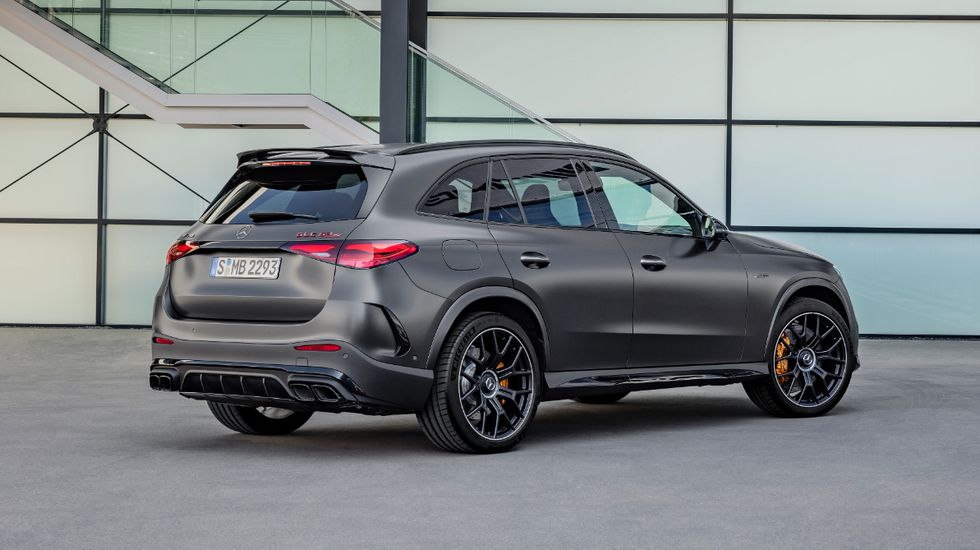- Mercedes-AMG is making it clear that performance crossovers are within its wheelhouse too, as it reveals the 2024 AMG GLC 43 and 2025 AMG GLC 63 S E Performance.
- Using the AMG M139l 2.0-liter four-cylinder, power figures range from 416 hp to 671 hp and 369 lb-ft to 752 lb-ft of torque, thanks to F1 induction technology and an electrified drivetrain.
- Pricing and curb weights have yet to be revealed, but Mercedes-AMG says we can expect the GLC 43 in dealers by early 2024 and the GLC 63 S E Performance available by late 2024.
At this point, it’s clear that automakers and potential enthusiasts as a whole have surpassed initial doubts about gobsmackingly quick SUVs. There’s no denying the popularity of crossovers and SUVs as a category, but the performance versions of otherwise mundane models have taken a particular precedent these days. And Mercedes-AMG is eager to join the party, as evidenced by its launch of two new GLC-Class performance models.
Known as the 2024 Mercedes-AMG GLC 43 and 2025 Mercedes-AMG GLC 63 S E Performance, both models are built on Mercedes’ relatively fresh MRA 2 platform, shared with the current generation C-Class and E-Class. But these low-slung crossovers differentiate themselves from luxury sedans with a key AMG component: power.
Powered by an AMG M139l 2.0-liter four-cylinder engine, the Mercedes-AMG GLC 43 features 416 hp and 369 lb-ft of torque, running through all four wheels thanks to AMG’s proprietary 4Matic all-wheel drive with rear-biased torque distribution. But the Mercedes-AMG GLC 63 S E Performance kicks it up a notch, adding propulsion from a 6.1-kWh lithium-ion battery and a 201-hp, 236-lb-ft of torque permanently excited synchronous electric motor for a total of 671 hp and 752 lb-ft of torque. Both models feed power through a unique AMG Speedshift, 9-speed Multi-Clutch transmission that uses a wet-clutch as opposed to a torque converter.
Notably, the M139l 2.0-liter engine has an ultra-modern feature whether electrified or not, as AMG boasts an electric exhaust gas turbocharger. Using a 6-inch thin electric motor, AMG has engineered the motor to sit in between the turbine wheel and compressor wheel, allowing for electronically controlled compressor wheel speeds up to 175,000 rpm. Simply put, the complex, F1-derived forced-induction system allows for consistent boost pressure from idle and unchanged acceleration regardless of circumstance.
Making all this power didn’t come easy, AMG says. In engineering the GLC 63 S E Performance, the company says it relied on a high-tech, non-conductive liquid coolant to flow around all 560 cells, thereby keeping the battery at its optimum temperature for power delivery of 113 degrees Fahrenheit. Additionally, in an effort to be gentle on the heavily relied-on battery, only AC charging will be offered through its 3.7-kW on-board AC charger. Mercedes-AMG also claims the electrified model will have an all-electric range, though it has yet to clarify just how far the performance crossover can go.
Even so, we do know how quick both models are, with estimated 0-60 mph times of 4.7 seconds for the AMG GLC 43 and 3.4 seconds for the AMG GLC 63 S E Performance. Topping out at 155 mph and 171 mph, respectively, both AMG GLC versions are certifiably fast. But the AMG mission goes beyond simple speed, and Affalterbach’s engineers were clearly eager to prove themselves with the performance crossover pair.
For starters, the suspension setup on both the GLC 43 and GLC 63 S E Performance is meant to balance comfort and dynamics thanks to a continuously adaptive damping system as well as selectable damping maps. These sorts of electronically controlled systems are par for the course, but AMG has specially developed a front end for the pair with model-specific steering knuckles and suspension joints. Turn-in is said to be sharper and more consistent as a result, though the GLC 63 S E Performance goes one step further by employing electromechanical, two-piece anti-roll bars that are activated by a chassis-centered actuator.
Active rear-steer is standard on both models, with a maximum angle of 2.5 degrees and oppositional steering at low speeds to increase maneuverability. At speeds above 62 mph, the rear wheel steering will mirror the front tires, further improving turn-in while also increasing stability. Beyond split steering, AMG also employs its drivetrain torque splits to improve on-throttle handling on both versions. Specifically, the GLC 43’s 4Matic AWD features a permanent 61% rear torque bias while the GLC 63 S E Performance’s rear-mounted electric motor helps allocate up to 100% of the torque rearward as needed.
Visually, the GLC 43 and GLC 63 S E Performance rightfully put off an aggressive aura, with gloss-black plastered AMG Night Package or carbon-fiber-forward AMG Exterior Carbon Fiber Package both available for purchase. Standard, AMG-specific exterior equipment includes the front fascia, rear diffusers, and twin tailpipe trimmings, while both interiors feature microfiber blend seats as well as an AMG Performance steering wheel and aluminum paddle shifters. Even track rats will appreciate the interior of the AMG GLC, as it features AMG’s Track Pace data logger, with a lap timer and accelerometers included.
Mercedes says the 2024 AMG GLC 43 will reach US dealers by early 2024, while the GLC 63 S E Performance won’t arrive until late 2024, making it a 2025 model year. A few key details—including curb weight, electric range, and pricing—have yet to be revealed, though Mercedes says we can expect these numbers closer to launch. Either way, the lineup’s specifications show it to be a pocket rocket of a crossover, indicating BMW may want to get to work on an X3M.
What is your favorite historic performance SUV? Please share your thought below.
Associate Editor
A New York transplant hailing from the Pacific Northwest, Emmet White has a passion for anything that goes: cars, bicycles, planes, and motorcycles. After learning to ride at 17, Emmet worked in the motorcycle industry before joining Autoweek in 2022. The woes of alternate side parking have kept his fleet moderate, with a 2014 Volkswagen Jetta GLI and a 2003 Honda Nighthawk 750 street parked in his South Brooklyn community.
Read the full article here




